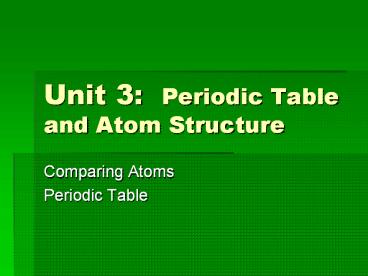Unit 3: Periodic Table and Atom Structure - PowerPoint PPT Presentation
1 / 30
Title:
Unit 3: Periodic Table and Atom Structure
Description:
Unit 3: Periodic Table and Atom Structure Comparing Atoms Periodic Table Types of Elements Types of Elements Why do atoms react? Valance Electrons Atoms are stable ... – PowerPoint PPT presentation
Number of Views:446
Avg rating:3.0/5.0
Title: Unit 3: Periodic Table and Atom Structure
1
Unit 3 Periodic Table and Atom Structure
- Comparing Atoms
- Periodic Table
2
Reading the Periodic Table
- What information is shown?
- Atomic Mass
- Atomic Number
- Element Symbol
- Element Name
3
Periodic Table
Element Name
Atomic Mass
Atomic Number
Element Symbol
47 Ag Silver 107.87
Which is which?
4
Periodic Table
Element Name
Atomic Mass
Atomic Number
Element Symbol
47 Ag Silver 107.87
5
Atomic Number
- Number of Protons
- What happens if you change the number of protons?
- Change the element
HUGE amounts of energy to add or remove.
6
Atomic Number
- Begin _at_ 1 ? 111
- Why is there more than 111?
- Heaviest elements are created by scientists.
- WHY?
7
Periodic Table
47 Ag Silver 107.87
Atomic Number
8
Atomic Mass
- Protons Neutrons
- Increase by amounts gt 1
- Different of Neutrons in nucleus.
- Neutrons dont change charge of atom
9
Isotopes
- Atoms with different amounts of neutrons.
A
1
1
1
M
1
2
3
-
-
-
Hydrogen- proteium
Hydrogen -deuterium
Hydrogen-tritium
10
Periodic Table
47 Ag Silver 107.87
Atomic Mass
11
0f Neutrons?
- Atomic Mass Atomic Number
47 Ag Silver 107.87
-47
61 Neutrons
108
12
Nucleus
- Opposites _ _ _ _ _ _ _
- Why does the nucleus stay together?
- Strong Nuclear Force
- Short distance
13
Periodic Table
Atomic Number
Element Symbol
47 Ag Silver 107.87
Element Name
Atomic Mass
14
Electrons ?
- Equal to the Protons
- Electron Cloud
- Never in the same place
- Buzzing
- Arranged in energy levels
15
Electron Levels
- Distance from nucleus increases energy .
16
Electron Levels
- The higher the level the more electrons it can
hold.
17
Electron Levels
- Orbitals
18
18
8
8
2
- We are only concerned with 8 per level
18
- Period or row 1-7, the number of electron shells
- Columns 1-8 , Group s tell you the of
electrons in the outer shell
1
(1)8
2
(1)4
(1)5
(1)6
(1)7
(1)3
1
2
3
4
5
6
7
19
Types of Elements
- Metals
- Solid at room temp
- Conduct heat electricity
- Shiny
- bendable
20
Types of Elements
- Non-Metals
- Gasses or liquids at room temp
- Do not conduct heat or electricity
21
Types of Elements
- Metalloids
- Next to the crooked line
- Exhibit properties of metals
- nonmetals
22
Types of Elements
- Transition Elements
- Transitioning from metal to
- non-metal
23
Types of Elements
- Halogens
- Bond easily with groups 1 2
- to make salts.
- Most reactive Non-metals
24
Types of Elements
- Noble Gasses
- These gasses are inert
- non-reactive
25
Types of Elements
- Alkali Metals
- Most Reactive Metals
- React with water violently
26
Types of Elements
- Alkaline Earth Metals
- 2nd most Reactive Metals
- React with many things, just not as much as group
1
27
Why do atoms react?
- Valance Electrons
- Atoms are stable only when their outer shell
(valance shell) is full. - Most of the time that means they need 8 valance
electrons (Rule of Octet). - Atoms gain or lose electrons to become stable
during a chemical reaction.
28
Why do atoms react?
- Gaining or losing electrons requires the same
amount of energy so - Atoms will gain or lose electrons based on how
many they have in their outer shell - Gaining or losing electrons results in a chemical
bond being formed and that atom becomes an Ion
(atom with a charge)
29
Drawing Atoms
Sodium Atomic 11
e-
e-
e-
e-
e-
e-
e-
e-
e-
e-
e-
30
Assignments
- Worksheets
- Unknown Elements
- Elements you NEED to know
- Mr. Bunt will be coming around to grade your
folder. BE READY!!!
31
Activity
- Pick 4 elements and draw their structure.(5 min)
- Move all desks to perimeter.
- Class in 2 groups.
- As a group pick an element and ACT out the
arrangement of the sub atomic particles. - 1 person can be the nucleus.
- The other team guesses the element of the acting
team
32
Electron Actors































